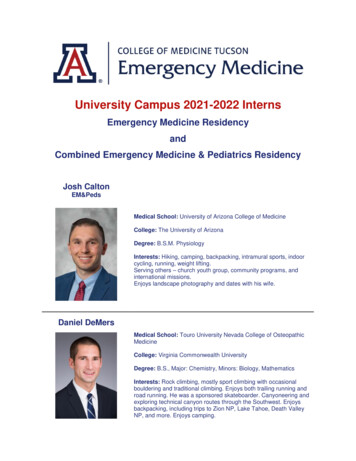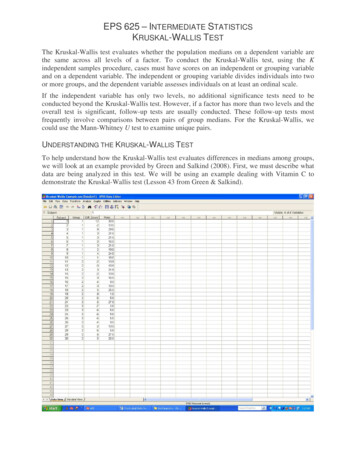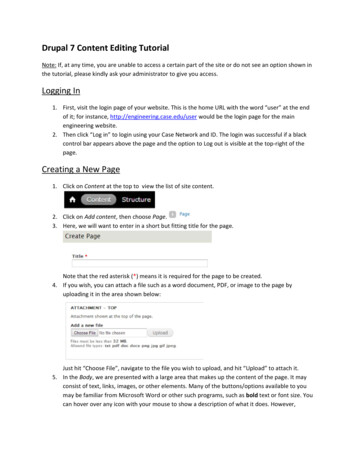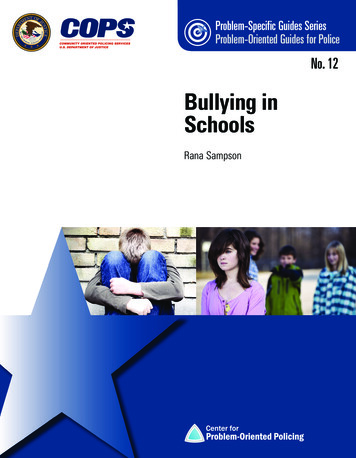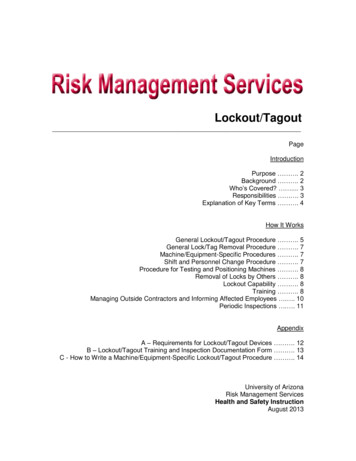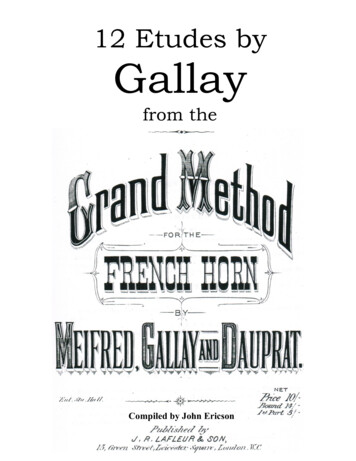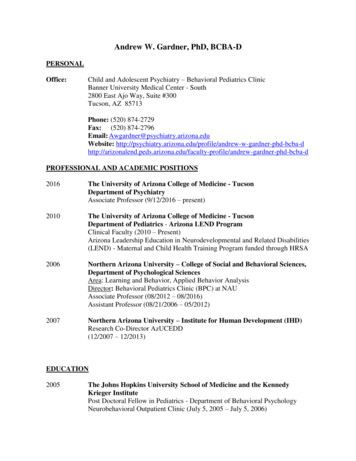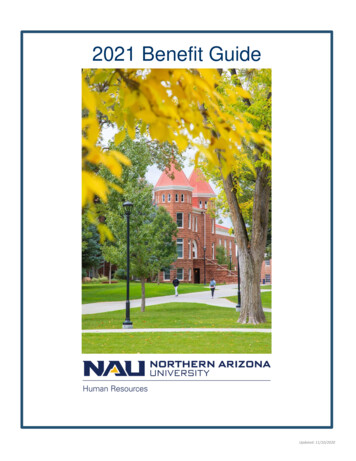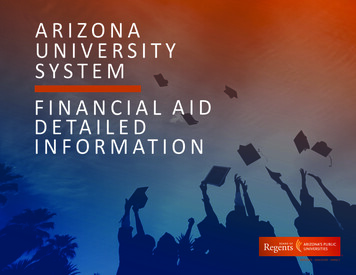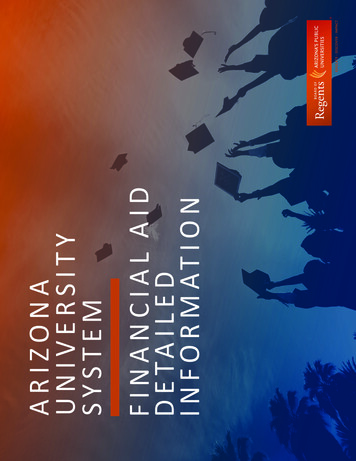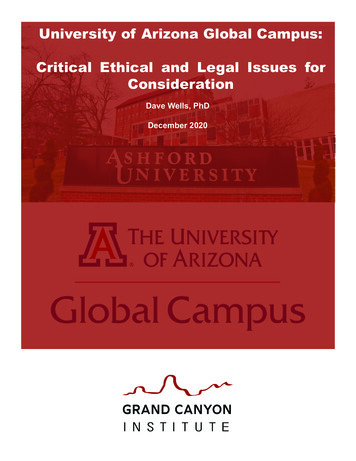
Transcription
University of Arizona Global Campus:Critical Ethical and Legal Issues forConsiderationDave Wells, PhDDecember 2020
Dave Wells holds a doctorate in political economy and public policy and is theResearch Director for the Grand Canyon Institute, a centrist fiscal policy think tankfounded in 2011. He can be reached at dwells@azgci.org or by contacting the GrandCanyon Institute at (602) 595-1025 ex. 2.The Grand Canyon Institute, a 501(c) 3 nonprofitorganization, is a centrist think tank led by a bipartisan groupof former state lawmakers, economists, community leadersand academicians. The Grand Canyon Institute serves asan independent voice reflecting a pragmatic approach toaddressing economic, fiscal, budgetary and taxation issuesconfronting Arizona.Grand Canyon InstituteP.O. Box 1008Phoenix, Arizona 85001-1008GrandCanyonInsitute.orgImage credit: New York Times (Ashford University); Wall Street Joural (University of Arizona)
University of Arizona Global Campus 3Executive SummaryThe acquisition of for-profit, online Ashford University by the University of Arizona (UA)raises a range of ethical and legal issues. Even if legal issues are proven to be moot, UAhas given insufficient indication that it intends to invest financial resources to improveAshford’s poor academic and student services raising the question that the deal ismotivated more by potential revenue and market share without regard for consequencesfor current and future students. Ashford University has a very low level of student success.o Ashford University has a very low graduation rate—most students drop outor transfer—and leave with outstanding federal loans and no degree.o The five-year student loan default rate was 47% in 2014.o It has been subject to numerous lawsuits—future liability if past practices dono change would now also fall on UA.o Its poor performance led to a formal letter of concern from its accreditingagency Western Association of Schools and Colleges Senior College andUniversity Commission (WSCUC) in 2019. Ashford University relies primarily on adjunct faculty with a questionable level ofacademic rigor and integrity.o Only 4% of faculty are full-time and less than 10% of courses are taught byfull-time faculty.o Only about 20 cents of each dollar in tuition presently goes to the facultyteaching courses.o The accreditor has noted shortfalls in faculty pay, excessive workload andinadequate faculty governance in its letter of concern. Ashford’s enrollment has declined significantly in the last decade and its financialstatus is questionable despite what appears to be a high tuition, low-cost educationmodel.o Zovio, Ashford’s parent company, has a continued pattern of operatinglosses.1 UA has been insufficiently clear in its priorities.o On one hand, the Ashford acquisition, with the plan to be branded asUniversity of Arizona Global Campus (UAGC), has been discussed as anew revenue center, suggesting that the intention is not to improve Ashfordbut to pull about 5% of net revenues for UA priorities.o On the other hand, UA claims it will not tolerate Ashford’s previous poorperformance once acquired—yet has not committed to the financialNote: On November 18, 2018 2020 GCI provided a preliminary analysis for the Board of Regents done onan expedited timetable due to the timing of their meeting after Ashford’s accreditor, the Western Associationfor Schools and Colleges Senior College and University Commission, gave conditional approval to theacquisition. Where findings have been correct it will be footnoted in this version. This version is moredetailed and has additional information.1 The November 18th analysis incorrectly noted the stock price as 1 cent. That is the par value not themarket value of the stock. Zovio stock sells at less than 4 per share. The stock surged to just above 6when the University of Arizona acquisition was announced in August, but the price has since fallen back toaround where it was before the announcement—suggesting that investors have less optimism about howthe deal will improve Zovio’s profitability. Since Zovio’s profitability is largely based on net revenues forUniversity of Arizona Global Campus, it suggests investors see less likelihood of enrollment growth. and Canyon Institutewww.grandcanyoninstitute.org
University of Arizona Global Campus 4investment to turn it around.o About 70%–80% of revenues will be funneled back to its current ownerZovio2, who has been responsible for the poor performance and will continueoperating the institution post acquisition.o Instead UA plans to continue UAGC’s current faculty model and the facultywill not be part of UA faculty.o UA will not include UAGC in its accreditation process with the HigherLearning Commission. Rather, it plans to keep it separately accredited withthe WASC Senior College and University Commission The acquisition raises critical questions regarding whether UA and by extensionthe Arizona Board of Regents are violating the credit and stock clauses of theArizona Constitution with this transaction.The 15-year Strategic Services Agreement between Zovio, UAGC, and the Board ofRegents/UA has a possible 7-year break point and designates Key Performance Indicators(KPI). The public version does not provide adequate details on them.3 GCI recommendsthe KPI include: Benchmarks during the next 7 years for reducing the 5-year student loan defaultrate to no more than twice the current rate of UA and increase the portion of loansrepaid for UAGC to at least half that of UA. Currently the default rate appears tobe four times that of UA.4 Benchmarks during the next 7 years for improving 8-year student completion ratesso that they are at least 60% of UA’s and cutting the withdrawal rate to no morethan 25%. Current completion rates are 40% of UA’s and nearly half of studentswithdraw.5 UAGC within the next three years expend a minimum of 30% of net tuition and feeson instruction, up from the current 19% as part of its plan to address these goals.By year 7 faculty investment should be at least 35% of net tuition and fees.2 Note the analysis for the Regents cited 19.5% as the share of net revenues above what Zovio willreceive. From the purchase agreement Zovio also is paid for its service costs as well. Collectively it willlikely represent about 70%-805 of UAGC net revenues. More details later in the report3 See Strategic Services Agreement, December 1, 2020, 0130532320000070/ex-101xstrategicservic.htm4 Analysis from Kevin Miller of The Century Foundation suggests currently Ashford’s five-year default rateis 26% more than four times UA’s 6%5 Analysis from Kevin Mller of The Century Foundation suggests Ashford’s current 8-year completion is23% compared to 61% for UA—so it would need to rise to 36%. Ashford’s current withdrawal rate is 46%,so it would need to be cut in halfGrand Canyon Institutewww.grandcanyoninstitute.org
University of Arizona Global Campus 5IntroductionIn early August, the University of Arizona (UA) announced plans to acquire AshfordUniversity for one dollar and hire Zovio, its then owner, to continue operating nearlyall aspects of the university for 15 years.6 Negotiations appeared to have commencedin March during the pandemic. This acquisition was outside of any long-term strategicplan for UA and has a number of similarities to Purdue Global Campus—the rebrandedacquisition by Purdue University of for-profit Kaplan University in 2017. Purdue hasseen operating losses since the acquisition7—but this deal is structured to insulate UAfrom operating losses. The deal closed on December 1, 2020. The U.S. Departmentof Education (USDoE) still must determine whether or not it considers the new entity afor-profit or nonprofit which impacts the manner in which it will be regulated in order toreceive Title IV funds (student loans and Pell grants). They may expect a letter of creditof at least 30 million from UA to award nonprofit status.Ethical Issues ConsideredSeveral ethical issues should be considered in relation to the acquisition of AshfordUniversity. Issues include the financial practices by the parent company, studentperformance and retention, reliance on adjunct faculty, and it appears that the deal willperpetuate emphasis on student recruitment rather than retention. Importantly, it is unclearif UA intends to invest resources in improving the quality of education provided.Ashford University and ZovioAshford University was a for-profit online institution owned and operated by Zovio, aprivate holding company that is traded on NASDAQ Zovio, formerly called BridgepointEducation, acquired what had originally been a Catholic women’s university in Iowa in2005 and renamed it Ashford University. It now offers completely online undergraduateand graduate degrees.8 In 2011 enrollment topped 80,000 FTE students. Before thepandemic it had dropped to about 35,000.Ashford University has a very low level of student successAshford University offers a lower quality university experience relative to UA.Documentation related to its pending acquisition provides no indication that UA intends toinvest in improving the quality of education provided to students. Rather, the focus seemsto be on expanding UA’s presence in the online higher education market while creating anadditional revenue source, without apparent concern for the quality of education provided.This has potentially serious implications for the UA’s brand. Key issues identified with6 Leingang, Rachel (2020), “University of Arizona looks to jump-start online enrollment with purchaseof for-profit college,” Arizona Republic, Aug. 3, ty-boost-online-enrollment/5575126002/7 Newton, Derek (2019), “Early Troubles in The Purdue, Kaplan Marriage,” Forbes, Aug. 31, 1/early-troubles-in-the-purdue-kaplan-marriage/?sh 79f78a1a670d.8 Doyle, Charlotte (2019), “Ashford University Lawsuit, History and My Disturbing Experience as a 2018Graduate,” February 11, Ugly.Grand Canyon Institutewww.grandcanyoninstitute.org
University of Arizona Global Campus 6Ashford University’s performance include:o Ashford University has a very low graduation rate—most students drop outor transfer—and leave with outstanding federal loans and no degree.o It has been subject to numerous lawsuits—future liability if past practices dono change would now also fall on UA.9o Its poor performance led to a formal notice of concern from its accreditingagent WSCUC in 2019, with WSCUC clearly restating that accreditationconcerns are ongoing in its letter providing conditional approval of theUAGC deal.10Ashford has very low levels of successful student completion based on data fromCollegeFactual.com—which seems to be based on and consistent with data from theIntegrated Postsecondary Education Data System (IPEDS) of the National Center forEducational Statistics.11 Table 1 compares Ashford’s performance for first-time, full-timestudents as well as returning full-time students.12 Ashford ranks in the bottom 10 percentof colleges and universities (about 3,500) tracked by CollegeFactual.com.Table 1Graduation Rates for Ashford University StudentsFirst-Time StudentsGraduation RateReturning StudentsGraduation RateClassof 2015AshfordNationalAvg.Percentileout of 1004 years1%34.1%9136 years9.5%45.%8 years9.8%47.4%AshfordNationalAvg.Percentileout of 100325.1%53.8%10326.1%55.1%9The Eller Faculty analysis from June found typical debt was about 36,000 per student.14Kevin Miller of The Century Foundation found a median debt level of 34,375 per graduatecompared to 20,000 for UA graduates. SEC filings indicate that that the 3-year defaultrate on federal student loans by Ashford students is about 40% higher than the national9 The preliminary version for the board of Regents incorrectly stated the University would assume alllegal liabilities. The purchase agreement (see pages 3 to 5) appears to insulate the University from liabilitybased on Ashford’s past practices. However, a recruitment over retention business model remains likely forUAGC--which could open to future liability.10 See letter from accreditor: m7m277yjbs1qzp92p1sb36j.pdf11 See Retention and Graduation at IPEDS for Ashford University: ofile.aspx?unitId 154022&goToReportId 612 Data for part-time students did not appear to be reliable. Whereas tracked student numbers for full-timestudents was 11,255 and 45,761 for first-time and returning students, respectively, part-time tracked datawas for 7 and 3 students, respectively.13 This percentile was out of a small total institutional base of 2,200—but seems odd for 1%. One percentis also reported at the IPEDS website for Ashford.14 Mergenthaler, Rick, Nathan Podsadoff, Hope Schau, Bin Zhang, David Brown, and Tiemen Woutersen(2020), Eller School of Business Faculty Letter to Board of Regents, President Robbins, Dean Goes andProvost Folks, June 19.Grand Canyon Institutewww.grandcanyoninstitute.org
University of Arizona Global Campus 7average (14% compared to 10%).15 However, in a 2018 General Accounting Office report itnoted many schools encourage student loan forbearance where interest accumulates butpayments are temporarily halted. This artificially reduces reported 3-year default rates.16Table 2 indicates that as of 2014, Ashford University ranked 10th nationally in totalaccumulated student debt on accumulated federal loans with 5.9 billion covering 205,000borrowers, despite its relatively short time as a growing for-profit enterprise. Notably, itranked ahead of Arizona State University Tempe campus whose students had 4.9 billionin federal student loan debt among 159,000 borrowers. The difference exists becauseASU students are far more likely to graduate and repay their debt. The 5-year defaultrate for the 2009 cohort at Ashford was 47% with only 2% of their balance on averagerepaid. By contrast the default rate at ASU was 17% with 12% repaid.17 The 2009 cohortenrolled in the Fall of 2005 when Ashford in its current form was just beginning. UA wasnot among the top 25 institutions with student debt so was not listed in the table. KevinMiller of The Century Foundation, using institution reported data, found the current fiveyear default rate to be 26% compared to only 6% for UA.18Table 2Selected Universities with High Levels of Student IndebtednessInstitutionTotal Debt(billions)TotalBorrowers5-Year DefaultRate for 2009Cohort (2014)% BalanceRepaid in 2014University of Phoenix 35.51,192,00045%1%Ashford University 5.9205,00047%2%Grand Canyon University 5.9146,00036%0%Arizona State University 4.9159,00017%12%Ohio State University 4.4133,00012%19%Source: US Treasury Tabulations of 4% of National Student Loan Data System Sample published inTable 5 of 2015 Brookings Papers.Not surprisingly, Ashford has been the subject of numerous lawsuits. As the Eller Facultyanalysis noted (Antelope is Ashford and Zebra is Zovio in the following text):For example, the California attorney general filed a lawsuit with Antelope University15 For National Federal Student Loan cohort default rates—see U.S. Dept. of Education, “Student LoanDefault Rates,” efault-rates. Ashford indicates threeyear cohort default rates for 2014, 2015 and 2016 of 14.9%,13.5% and 13.7%, respectively. See page 94of Zovio Year Ending Dec. 31, 2019 Annual Report to Securities and Exchange Commission, https://s23.q4cdn.com/742949744/files/doc 94e4d.pdf.16 United States General Accounting Office (2018), “Federal Student Loans: Actions Needed to ImproveOversight of Schools’ Default Rates,” April, GAO-18-163, https://www.gao.gov/assets/700/691520.pdf.17 Looney, Adam and Constantine Yannelis (2015), “A Crisis in Student Loans? How changes in thecharacteristics of borrowers and in the institutions they attended contributed to rising loan defaults,”Brookings Papers on Economic Activity, September, https://www.gao.gov/assets/700/691520.pdf.18 Miller, Kevin (2020), Memo “Ashford University’s student outcomes and instructional spending,” Oct.6. Miller’s numbers seem to be systematically lower than the Brookings Papers. This could be due to astronger economy at the time and/or differences in methodology. Miller’s data is from IPEDS which isreported by Institution, whereas Brookings was directly from a national database of borrowersGrand Canyon Institutewww.grandcanyoninstitute.org
University of Arizona Global Campus 8in 2017, which is ongoing to our knowledge. In 2014, Zebra settled a lawsuit withthe State of Iowa for 7.25 million. In 2016, the Consumer Financial ProtectionBureau levied an 8 million penalty on Zebra and required them to refund 23.5million in student loans.19While the purchase agreement seems to insulate UA from liabilities from past actions.Future lawsuits for poor service to students would fall on UA as the new operator.In July 2019 Ashford’s accrediting agency issued a formal notice of concern which stated:The Formal Notice of Concern is being issued due to the Commission’slongstanding concerns regarding Ashford University’s student persistenceand completion rates and performance on other student success metrics. TheUniversity is in danger of being found out of compliance with Standard 2 unlesssignificant improvements are realized in the near future.20In September 2020, Veterans Education Success, a nonprofit that advocates onbehalf of veterans, issued a memorandum to the Federal Trade Commission detailingnumerous possible deceptive and fraudulent practices by Ashford University inrecruiting veterans that could violate federal law.21Ashford University relies primarily on adjunct facultyAshford University does not detail on its website anything about its faculty except a bitof information found in a blog area that is quite challenging to locate. In its 2019 AnnualReport to the Securities and Exchange Commission for the year ending Dec. 31, 2019,Zovio indicates Ashford employed 100 full-time faculty and 2,509 active adjunct faculty,which means less than 4% of faculty are full-time.22 At most 12% of courses are taughtby full-time faculty, though that figure was based on 215 full-time faculty employed forfiscal year 2018.23 The current portion of classes taught by full-time faculty is likely farless than 10% because Ashford eliminated half their full-time faculty since then. Since thehighpoint was reached for an accreditation visit and half the full-time faculty have sincebeen eliminated, critical integrity issues are raised.By their financial information, Zovio spends significantly more on marketing than it doeson faculty compensation. The accreditor report indicates that about 36% of expenseswere in the form of “Admissions Advising & Marketing”—which is technically all marketingrelated.24 By contrast IPEDS indicates that instruction expenses were only 21%19 Mergenthaler, Rick, Nathan Podsadoff, Hope Schau, Bin Zhang, David Brown, and Tiemen Woutersen(2020), Eller School of Business Faculty Letter to Board of Regents, President Robbins, Dean Goes andProvost Folks, June 19.20 Studley, Jamienne S.-President (2019), Letter from Western Association of Schools and Colleges to Dr.Craig Swenson President of Ashford University, July 12.21 Veterans Education Success (2020), “Memorandum Regarding Ashford University to the Federal TradeCommission,” Sept. 28, /.22 See page 10 of Zovio Annual Report to Securities and Exchange Commission for the year endingDec. 31, 2019, htt
University of Arizona Global Campus 4 Grand Canyon Institute www.grandcanyoninstitute.org investment to turn it around. o About 70%–80% of revenues will be funneled back to its current owner Zovio2
